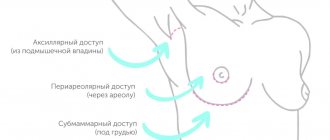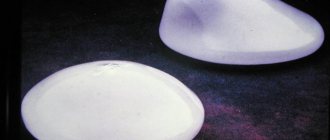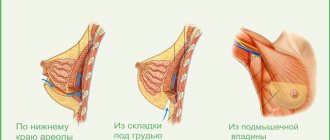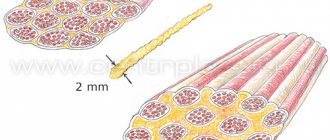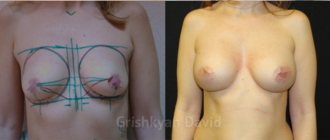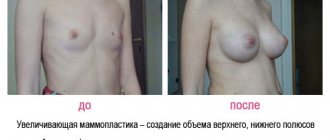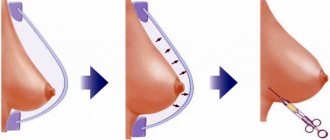Breast augmentation is one of the most popular “female” plastic surgeries. Women's dissatisfaction with the size or shape of the breast leads them to see a plastic surgeon: after all, most of them want to have lush and seductively firm breasts.
Breast augmentation is a complex procedure that requires careful preparation on the part of the patient, as well as strict self-discipline. This greatly contributes to the success of the operation, and also allows you to go through the rehabilitation process without losses in order to fully experience the joy of owning new sexy breasts.
In order to more fully inform you about the nuances of this intervention, we suggest that you familiarize yourself with the most pressing issues regarding breast augmentation.
Anatomy and physiology of the breast
The mammary gland consists of the following tissues:
- fat;
- glandular;
- connecting.
Also contains sensory nerve fibers and blood vessels. Below the mammary gland is the pectoralis major muscle.
A woman's mammary gland often undergoes changes in mass and volume throughout her life. This leads to an irreversible aesthetic evolution of the breast. With age, the volume of glandular tissue decreases and is replaced by fat cells. Adipose tissue, due to its physical properties, has a significant impact on changing the appearance of the breast. In terms of beauty, it is difficult to talk about the norm, but in the relief anatomy of the female body, there is a distinction between the aesthetic norm of the breasts of a young girl and a mature woman.
ADVANTAGES OF CARRYING OUT THE PROCEDURE IN BELARUS
The level of medicine in the country is quite high, so many patients from neighboring countries want to have breast surgery in Belarus: it is economical, fast and safe. Our specialists will help you choose a clinic and prepare all the necessary documents, coordinate the time of arrival in the country and visit to the clinic. We take care of all the hassle of organizing the patient’s accommodation and travel, communication with the clinic and the doctor who will perform the operation. If necessary, we help with organizing postoperative care.
Have you always dreamed of breast enlargement? Call or fill out an application: we will help you realize your dream with maximum health safety.
Leave a request +375 29 936-03-03
Breast implant
The breast prosthesis resembles a reservoir, its shell is made of silicone elastomer. Inside there is one of the most common fillers, which differ in the degree of foreignness to the body and nature:
- saline;
- silicone gel;
- biocompatible gel.
Implants are distinguished:
- in shape: round and anatomical;
- by shell quality: smooth, textured and microtextured.
Let's take a closer look at each type of breast implant.
Summary
- Installing breast implants is the only way to solve the problem of small breasts.
- The result will be simply amazing if you approach the issue with all responsibility, take into account the available indications, choose the optimal implantation technique and correctly select the breast size.
- You can trust your health and appearance only to an experienced specialist who will choose the surgical method in strict accordance with the indications and take into account subjective data.
- Preference should be given to modern silicone implants with a textured multilayer surface.
- A change in appearance entails other changes, and, as a rule, positive ones. This is associated with increased self-esteem and gaining self-confidence.
- It is important to remember that there is also a potential risk that cannot be foreseen, such as the development of capsular contracture.
But in the same way, you need to understand that any, even the most insignificant intervention, is risky to one degree or another. And the basis for success is the rich practical experience of a competent plastic surgeon plus the patient’s responsibility for strict adherence to his recommendations.
Implants filled with silicone gel
American surgeons from Houston Thomas Cronin and Frank Gerow in 1961 invented implants that were filled with silicone gel. And this discovery was a real breakthrough in breast plastic surgery. The authors of the invention sold the patent for production to Dow Corning Corporation. The first operation with this type of implants took place in 1962. However, over time, numerous patients began to file lawsuits against Dow Corning due to side effects.
The fact is that the first implants were not sufficiently refined. The poor quality of the products almost brought the corporation to bankruptcy, and it had to abandon this line of business in the United States. Fifth generation silicone-filled implants are generally recognized and approved today. Depending on the manufacturing company, they have some distinctive characteristics and properties, but they have one thing in common: their implantation does not cause the development of autoimmune or carcinogenic processes in the female body. Every day, the best specialists and institutes study their safety, monitoring the quality of implants.
Important information
In modern medicine, there are extremely stringent requirements for materials that can be used in the manufacture of endoprostheses. They are required to:
- lightness and plasticity;
- chemical indifference;
- stability in terms of physical properties;
- hypoallergenic and lacking carcinogenic properties.
In addition, their shell must be thin, but very durable, and also be subject to sterilization. Breast implants, which are used by plastic surgeons at our center, fully meet these requirements.
Implants filled with saline solution
Physiological is a 0.9% solution of table salt in water. That is why implants with saline as a filler are called “saline” or “saline”. In 1964, the French surgeon Henri Arion presented his discovery to the world: the silicone reservoir of implants can be filled not with foreign silicone, but with saline solution. The technology also implied the elimination of many complications that were caused by silicone implants. However, scientists continued the search for the ideal filler. An excellent alternative to silicone gel and saline. The solution eventually became biogel.
Result
It should be noted that among the patients the absolute majority are satisfied because:
- the result is noticeable immediately after the correction;
- the result is sustainable - modern endoprostheses have a lifetime warranty;
- the rehabilitation period is kept to a minimum and the requirements are minimal;
- traces of surgery quickly become invisible;
- After prosthetics, breastfeeding is possible.
For the operation it is necessary to undergo a number of tests:
- Complete blood count + platelets + coagulation (valid for 10 days)
- Blood type, Rh factor
- Coagulogram (valid for 10 days)
- General urine test (valid for 10 days)
- HIV test
- RW blood test (valid for 1 month)
- Fluorography (valid for 12 months)
- Blood test for hepatitis B, C (valid for 1 month)
- Biochemical blood test (total protein, sodium, potassium, calcium, chlorine, cholesterol, urea, creatinine, glucose, total bilirubin, direct bilirubin, AST, ALT, chlorides) (valid for 10 days)
- ECG with interpretation (cardiologist's report if necessary) (valid for 1 month)
- Physician's conclusion for persons over 50 years of age (valid for 14 days)
- In the presence of chronic diseases - an extract from the outpatient card with a physician’s conclusion (valid for 14 days)
- Ultrasound of the mammary glands
Read reviews from our patients >>
Implants filled with carboxymethylcellulose gel (biogel)
In the early 80s, the same French surgeon Henri Arion presented his innovative development - biogel implants. It took the scientist 10 years of laboratory and clinical trials to create them.
Biogel is a natural polymer (3.7% solution of CMC - carboxymethylcellulose), which is obtained from cellulose. The filler does not give the feeling of a “dense” breast, like silicone, and does not “gurgle” with movement, like saline solution. Also, if silicone gel gets into the tissue, it can only be removed through surgery. And biogel has the property of biodegradation, i.e. – spontaneous resorption. This means that if the implant shell is damaged, the biogel in the tissues will disintegrate into glucose, water and carbon dioxide.
Operation techniques
Today there are several techniques, from which the doctor chooses the most preferable.
- Submammary access is one of the most popular. Incisions are made under the breasts and after healing, the stitches are hidden in a natural crease. This access makes it possible to achieve perfect symmetry, which is very important. If there is bleeding, it is easy to stop.
- Axillary access is made from the armpit, where the postoperative suture is subsequently hidden. This technique allows you to install the implant both under the gland and under the pectoral muscle. Achieving symmetry with this approach is more difficult, and the likelihood of anesthesia of the nipple-areolar complex after surgery increases.
- The periareolar technique involves making an incision around the perimeter of the areola. It is good because the postoperative scar is practically invisible, but its use requires an areola of significant diameter. Disadvantages include frequent loss of sensitivity in the surgical area. But this method is very convenient for breast augmentation in combination with breast lift.
- The transareolar approach involves an incision in the areola itself. For subtle scars, there is a high risk of damage to the glandular ducts, so it is used selectively.
Implant surface
The implant shell can be smooth or textured. After installation of the implant, a fibrous capsule is formed around it. This is a normal reaction of the body to the presence of a foreign body in the soft tissues. However, sometimes the capsule is too tight and puts excessive pressure on the implant shell. This can cause deformation of the breast contour. This phenomenon is called capsular contracture. In order to reduce the risk of its development, implants with a textured shell began to be used. However, the question of what type of surface implant should be chosen should be discussed directly with your surgeon.
Implants coated with micropolyurethane foam are also available on the market. Their use minimizes the risk of a rough capsule. But despite this, such implants are still not widely used due to the fact that the breakdown products of polyurethane are carcinogenic. The concentration of carcinogens is extremely low, and doctors agreed that there is no good reason to completely abandon such implants; most often they are recommended to be used for repeated operations in the event of capsular contractures. It is clear that even a small risk of cancer makes many people think about looking for alternative options.
Consultation with a plastic surgeon
Consultation is the first step on the path to plastic surgery. It is at the consultation that a realistic idea of the intervention, probable risks, and nuances of the postoperative period is formed. When answering the surgeon's questions, a woman should be extremely frank. And be sure to listen to everything the doctor says.
Fundamental to satisfaction with the result of plastic surgery is the formation of adequate expectations, as well as awareness of possible risks and nuances of the rehabilitation period. And the most important thing is to understand your own responsibility for the course and outcome of the recovery stage.
The surgeon is interested not only in the current state of health. In addition to palpation examination of the mammary glands during the consultation, he will definitely ask questions about at what age they began to form, how the breasts “behaved” during pregnancy and lactation, how long breastfeeding lasted and how long ago it ended. He will also ask about the presence of breast cancer in close relatives, and will study the results of examinations by a mammologist, which should be carried out twice a year.
The next issue that is resolved at the consultative stage is determining the size of the future breast. Most women want new breasts of size 2-3, i.e. "B" or "C". Some bring photos from glossy magazines with the request “make breasts the same.” But none of the women can be completely sure of the correct choice. To make the task easier, we suggest trying on sizers - unique breast models that are identical in shape, volume, and weight to real mammary glands. Thus, the patient can feel as fully as possible as the owner of breasts of the declared size, and, based on her own feelings, finally make a choice. Sometimes simply “trying on” the implants is enough.
Cut location
During operations to increase breast size, three types of surgical access are possible: around the nipple (peripapillary), in the breast fold (inframammary), in the area of the armpit (axillary). Let's understand the differences between different types of access.
- Peripapillary. The trace of the incision is barely noticeable, however, the degree of trauma to the glandular tissue is much higher compared to other incisions.
- Podgrudny. The cut leaves more noticeable marks, but the gland tissue does not suffer in any way.
- Axillary (in the armpit). The incision leaves behind noticeable marks, the scars are often pigmented and prone to hypertrophy, control of the correct placement of the implant is difficult, and the glandular tissue is minimally injured.
In each case, the surgeon chooses the location of tissue dissection and the method of implanting the prosthesis together with the patient.
When the question of mammoplasty is resolved positively
- The doctor must be informed about all chronic diseases, as well as about previous surgical interventions. If you are taking any medications, you should also say this, since some medications affect blood clotting and the intake of such medications must be adjusted.
- Two weeks before the day of the intervention, it is important to stop smoking to ensure the wound heals as quickly as possible. Smoking slows down this process, worsening microcirculation and narrowing the capillaries in the operated area. In addition, smokers have an almost 10 times higher risk of developing complications.
- If you have doubts or additional questions immediately before the intervention, be sure to talk with the surgeon, and do not leave any unclear points under any circumstances.
- To wear after surgery, you need to buy a special support bra - sports or surgical.
- At the time of surgery, your weight should have been stable for the past several months.
The surgeon will explain to you the features of the operation and anesthesia, tell you where the incisions will be made and why this particular technique was chosen, inform you about the potential risks and possible side effects, and also describe or show a photo of the hospital where you will spend the first day after the operation. The cost of the operation will also be announced to you before the intervention.
Immediately on the day of surgery, your breasts are photographed in order to compare the condition and appearance “before” and “after” the intervention. The surgeon then marks the intended access sites.
Rehabilitation period after surgery
The tissues adapt to the new breast size, and this may take some time. That is why, in the postoperative period, the patient may experience pain, swelling, increased sensitivity, fatigue and tension.
To facilitate this period, the following are used to support and fix the breasts:
- Elastic bandages.
- Special bras.
Throughout the rehabilitation period, the patient is observed by a surgeon. As a rule, it is possible to return to work in the office within 2-3 days after a successful operation. However, for at least 1 month (often longer), significant physical activity should be avoided, sports and physical labor should be avoided.
Despite the fact that breast augmentation is a plastic surgery, it may not be performed on all patients. After all, this is a common surgical intervention, which has exactly the same risk of complications as other operations. Breast augmentation is a surgical operation for which there are a number of contraindications.
POSTOPERATIVE PERIOD
After the operation, for the first three days the patient is in the hospital under the supervision of a doctor to eliminate all risks. In the future, until the incision sites are completely healed, she can remain in the hospital or move to a hotel and come only for examination and dressing.
In the first 2 weeks there is severe swelling and movement is difficult. At this time, the patient cannot raise her arms above shoulder level; sudden movements and heavy lifting are contraindicated for her. Therefore, at this time, it is advisable to have a loved one or a nurse nearby to help with basic self-care.
The recovery period lasts at least a month - during this time it is necessary to wear compression garments. The mammary glands take their final shape after 2 months (swelling and bruising completely disappear). But the shape of the breast may still change within a year after surgery.
During the first week, drug therapy is often prescribed—painkillers and antibiotics—to prevent the wound from becoming infected.
Breast augmentation with implants: contraindications
Plastic surgery for breast augmentation will not be performed on patients under 18 years of age. Firstly, it is harmful for a young, not yet formed organism. It is necessary to wait until puberty is complete and the girl reaches adulthood.
As for those who have reached the age of 18, have learned the details and price of breast augmentation with implants, and are ready for it, it is worth paying attention to a number of contraindications.
- Concomitant severe diseases of the heart, lungs, liver, kidneys, etc. It will be difficult for a sick body to endure stress, even from plastic surgery.
- Breast augmentation with implants may be refused if you have decompensated diabetes mellitus. Wound healing in diabetics is more difficult, and purulent-infectious complications are possible.
- The presence of autoimmune disorders and infectious processes in the body will also become an obstacle to the operation.
- Severe lung diseases, blood clotting disorders.
- Fibrous cyst of the mammary gland and oncological diseases of the organ.
- Breasts will not be enlarged if there are hormonal disorders; you will first have to undergo treatment.
- Skin diseases of an infectious-inflammatory nature, especially in the area of the intended incision.
It is not prohibited, but it is not recommended for nulliparous women to undergo breast augmentation. Although modern surgeons do not see anything wrong with this. After pregnancy, it is much more logical to correct both shape and size, since the breasts can become deformed.
In any case, you will need specialist advice. Only a surgeon can tell you the exact cost of breast augmentation with implants. Confidence Medical Center makes appointments by calling:
- +375 (17) 353-70-73
- +375 (17) 375-69-09
- +375 (44) 715-69-14
- +375 (29) 865-20-90
- +375 (25) 744-49-66
- A1, MTS, Life 7125
The services of the Confidence Medical Center will help you forget about illnesses and health problems, giving you back a full life.
Breast plastic surgery - mammoplasty
The ideal breast shape no longer seems like a pipe dream. It is necessary to understand that mammoplasty
It is classified as a serious surgical procedure and is performed under general anesthesia, although the high level of modern medicine makes it possible to reduce the risks and discomfort of this operation to a minimum.
In order to dispel all fears and doubts, we have collected the most complete information
about preparation for the operation, its implementation and postoperative recovery and answered the most exciting and frequently asked questions. We want you to be confident in your decision and excellent results.
- Breast Anatomy
- Augmentation (enlargement) of the breast
- Mastopexy (breast lift)
- Preparing for surgery
- How is the operation performed?
- After operation
- Complications
- Questions and answers
Breast Anatomy
Women's breasts are a symbol of beauty, femininity and sexuality. It is made up of skin
, under which there are
the gland itself with milk ducts and adipose tissue
. Adipose tissue largely determines the softness of the breast and its external shape. The elasticity of the skin also affects the shape of the breast. Pregnancy (during which the breasts temporarily increase in size) and the inevitable effect of gravity over time stretches the skin pocket and changes the shape of the breast.
Augmentation (enlargement) of the breast
Augmentation is one of the most popular plastic surgeries not only throughout the world, but also in Belarus.
The most effective way to increase breast size is by inserting implants under the mammary gland. What are breast implants?
Since the reasons why women seek breast augmentation are always individual, a wide variety of implants is necessary to achieve the desired result individually for each woman. The implants consist
made of a silicone shell, which is filled with silicone gel of varying viscosity or a water-salt solution. They can have a round or teardrop-shaped (anatomical) shape, a textured or smooth surface, and also vary in profile and size.
Breast implants with silicone filler
soft and natural looking. Most surgeons prefer breast implants with silicone filler. The protective layer of the implant is a silicone shell, specially created to make the top layer as durable as possible, extend its service life and prevent gel leakage. The variety of possible types of implants will help you achieve the desired result that suits a specific patient.
Surgeons at the Medrekplast Center for Plastic Surgery and Cosmetology in Minsk will explain to you in detail all the possible options. Trust their experience and knowledge in choosing the most suitable endoprosthesis for you, but remember that patients who are involved in choosing the size of the implant are more likely to be satisfied with the result of the operation.
Implant positioning
Talk thoroughly with your surgeon about the positioning of breast implants. You must know what options are possible and what results can be expected in each individual case. The positioning of the implant mainly depends on the thickness of the covering tissue.
- With a subglandular
approach, the implant will be located on the pectoral muscle under the mammary gland. This access will cause minimal discomfort and allows you to quickly return to your daily activities. - With a submuscular
approach, the implant will be located behind the pectoral muscle. With this approach, an additional layer of muscle tissue is formed above the implant, which creates fewer obstacles and greatly facilitates mammographic examination of the breast. - With subfascial (combined)
access, it is possible to obtain better coverage of the implant without damaging the pectoralis major muscle. This access requires a highly qualified operating team.
You can obtain more detailed information about possible options for implant positioning, the advantages and disadvantages of one or another method from our surgeon.
Cut location
The location of the incision that is suitable in your case will be determined with the surgeon. You must understand that a scar will remain in this place.
- With an inframammary
incision, the scar will be located in the inframammary fold under the breast. The scar will be invisible in the presence of a medium and large mammary gland (i.e., with an initially pronounced submammary fold). - The advantage of the periareolar
approach is the maximum possibility of hiding the incision line. With such an incision, the scar will be almost invisible due to its location at the edge of the areola and the difference in color between the areola and the breast tissue. - With a transaxillary
incision, the implant is positioned through an incision in the armpit. It is used most often for small breasts and a small nipple-areolar complex.
The last two accesses do not affect the further possibility of lactation
(feeding the baby).
The advantages and disadvantages of the location of each incision are discussed in detail by the surgeons of our Medrekplast Center for Plastic Surgery and Cosmetology in Minsk with each patient.
Photos of patients before and after breast augmentation surgery
which were carried out at our Center for Plastic Surgery and Cosmetology “Medrekplast” in Minsk
Mastopexy (breast lift)
Mastopexy (breast lift)
- plastic surgery to remove excess breast skin.
Indicated
mainly for women with sagging breasts due to age-related skin changes or after childbirth and breastfeeding, and with a small volume of the gland.
For overweight women, as well as with large breasts, the best result is achieved by a combined reduction mammoplasty
and mastopexy (removal of not only excess skin, but also fatty tissue and glandular tissue).
For women with small breast volume, lifting surgery is often combined with breast augmentation using implants.
Normally, the nipple is located above the inframammary fold and is at the level of the middle of the shoulder for any woman’s height. Severity of ptosis (drooping) of the mammary gland
determined by the ratio of the nipple to the level of the inframammary fold (fold under the breast). There are the following options:
- Ptosis of the first degree
- the nipple is at the level of the submammary fold. - Ptosis of the II degree
- the nipple is located below the level of the inframammary fold, but above the lower contour of the gland. - Ptosis of the third degree
- the nipple is located on the lower contour of the gland and is directed downwards. - Pseudoptosis
- the nipple is located above the inframammary fold, the mammary gland is hypoplastic, and its lower part is drooping - Glandular ptosis
– the nipple is located above the projection of the inframammary fold, the gland has a normal volume, and its lower part sags excessively (occurs in the long term after reduction mammoplasty).
For any type of breast ptosis in combination with different volumes of the mammary gland in our Center for Plastic Surgery and Cosmetology "Medrekplast" in Minsk
A combination of plastic interventions that best suits your situation will be selected for you.
The experience of our surgeons allows us to perform any mammoplasty operations
.
Contraindications:
- such severe general diseases as hypertension, diabetes mellitus, systemic diseases, cancer, mental disorders;
- breast tumors, including benign neoplasms;
- not recommended for women planning to have children in the future, since pregnancy and breastfeeding will inevitably lead to initial breast sagging;
Breast augmentation surgery lasts on average from two to four hours
and is performed under
general anesthesia
.
Before the operation, the doctor measures the breast and makes markings. The surgeon makes an incision down from the nipple and along the crease under the breast, excising excess skin and moving the bulk of the gland upward. In some cases, when the breasts are small, a small incision along the border of the areola (the dark space around the nipple) is sufficient. In this case ( concentric breast lift
), a small amount of skin around the areola is excised and post-operative stitches are least noticeable. Finally, cosmetic stitches are applied, drainage is installed if necessary, then a bandage and special compression garments are installed.
Photos of patients before and after breast lift surgery
which were carried out at our Center for Plastic Surgery and Cosmetology “Medrekplast” in Minsk
Preparing for surgery
Before the operation you must:
- get a consultation with a mammologist and get a mammogram
- complete all prescribed examinations and tests
- talk to an anesthesiologist
- Tell your surgeon and anesthesiologist about all medications you are taking
Two weeks before surgery you cannot:
- smoke
- drinking alcohol
- sunbathe, as ultraviolet radiation suppresses the immune system
- take medications that reduce blood clotting, including aspirin
On the day of surgery:
- Three to four hours before surgery, large meals and liquids are prohibited. But this issue should be discussed with the anesthesiologist, as this directly affects the safety of pain relief.
- You should not apply active cosmetics to the body, as this worsens the marking and it wears off faster. It is advisable to strive for the absence of skin irritation.
- Hair, if present, must be shaved immediately before surgery. This should not be done in advance (6-10 hours in advance), since the irritation that may occur is one of the potential possibilities for the development of infection.
How is the operation performed?
You come with ready-made tests. The administrator draws up a medical history. You fill out the necessary documents and sign consent for the operation. The administrator escorts you to the room, where you change into disposable underwear, which is required in order to enter the operating room. Then you go to the surgeon and clarify all the details with him.
This is followed by an examination by the surgeon and anesthesiologist, after which a decision is made on the possibility of performing the operation at the moment. A photo of the breast is usually taken from the front and side (without the face). The incision lines, the detachment zone and the location of the implants are marked on the skin with a special marker. After the injection and installation of an intravenous catheter, the medicine is delivered into the vein and you fall asleep and wake up only after the operation. After applying the bandages, you will be put on compression garments.
After operation
Painkillers will be prescribed in the postoperative period
. Typically, a re-examination is carried out on the second or third day after surgery. Then as needed. After two weeks, the stitches are removed. And recently, with the use of modern suture materials, the sutures are not removed at all. Subsequently, regular follow-up examinations are carried out.
Due to postoperative swelling and individual characteristics of the body, breasts may appear larger
.
This is a normal process. Sometimes after surgery, scars
may be dense and red for the first two months, and then turn into white threads, lighter than the surrounding skin.
Immediately after the operation, the breasts may be dense, unnatural at some points, but after two to three months
they will become soft and take on their natural appearance.
A complete woman will usually begin to psychologically associate herself with her new appearance after three to four months
.
How to behave after surgery
- Any physical activity is not recommended for a month
.
It is recommended to relieve the shoulder girdle as much as possible. In the first days after the operation, it is necessary to strictly limit the movements of your arms, especially if your implants are located under the pectoralis major muscles. It is not recommended to raise your arms above shoulder level
, as certain tissue trauma and the formation of blood accumulations are possible. - After surgery, the use of special compression garments is indicated
. It helps to optimize the position of the breast, which creates a more aesthetic shape; it also performs a stabilizing function, which will make the postoperative period easier and reduce pain. - A periodic increase in body temperature up to 37.5°C is possible. This is an acceptable norm.
You can take a non-steroidal anti-inflammatory drug as recommended by our surgeon. - With your usual diet, you should not consume too much liquid
, especially if significant swelling develops.
You should limit your consumption of spicy foods
until the signs of inflammation disappear. - During the postoperative period, large doses of alcohol and smoking should be completely avoided
. - Only on the fifth day after the operation is it possible to take a shower
, and it is very important to regulate the temperature of the water (the shower must be taken neither cold nor hot).
It is not recommended to touch the postoperative areas with a towel or vigorously rub them. After taking a shower, be sure to disinfect
all seams with a cotton ball moistened generously with alcohol. - Increased physical activity
, as well as sports, are allowed only a couple of months after the operation.
Complications
Typical surgical complications are bleeding and infection.
Bleeding
usually opens in the first day or two after surgery. According to international statistics, about 1%, i.e., every hundredth woman. This will require surgery. Most often, if it is stopped in time, this does not affect the positive prognosis of the operation.
Infection
is a more serious complication. If it is present, it is extremely difficult to save the implant. This will most likely result in removal of the implant. Repeated surgery is possible no earlier than six months later. But this is an extremely rare complication; its frequency, regardless of the clinic, is less than 1%.
It is believed that accumulated blood
It should not be removed and it will resolve itself over time.
It has been proven that blood around the implant, even if it resolves, in a large number of cases will lead to the formation of capsular contracture
. But even in the absence of a hematoma and any hidden infections, which can also cause capsular contracture, there is a possibility that over time one or both breasts will become dense, possibly painful, difficult to move and deformed. This condition is called capsular contracture. It is characterized by the fact that the capsule that surrounds such a foreign body, which is the implant, becomes too dense and begins to squeeze it. This will not lead to tumors or any other health complications. This primarily affects aesthetics. Treatment is removal of the capsule. It is possible to reinstall another implant. Most often, this complication occurs in the first year after surgery and the probability is about 3-5%.
Questions and answers
Which implants are better – with a smooth or rough surface?
— Rough (textured). Such a surface makes it possible to reduce the likelihood of developing breast fibrosis after surgery by several tens of times.
How soon after breastfeeding can mammoplasty be done?
— Optimally in a year, provided that you reach your normal weight and the end of the gland changes, but at least six months later, if the body is already stable and the cycle has been established.
Is it possible to give birth and breastfeed after surgery?
- Of course - after all, breast surgery does not affect the ability to conceive or give birth in any way. We generally do not advise becoming pregnant in the first year after surgery. But only because lactation and breast swelling can have a bad effect on the shape of the mammary glands. After a year, childbirth is possible without fear for the shape of the breast; it is only advisable to maintain lactation at a moderate level. Installed implants usually do not interfere with lactation.
Will I be able to breastfeed after plastic surgery?
- You can after the vast majority of operations. There are operations that require quite traumatic dissection and redistribution of gland tissue due to the peculiarities of its development. During such operations, the part of the gland that is cut will not feed, but part of the gland may remain feeding.
Is it difficult to damage the implant?
- Extremely difficult. You will most likely never know about this, since the gel that fills the implant does not leak and does not have any negative effects on the body.
Can the sensitivity of the areola and nipple decrease?
- Some women experience changes in the sensitivity of the areola and nipple after surgery. Reduced sensitivity usually recovers within one month after surgery.
Can I take sick leave for the postoperative period?
- No. Sick leave for aesthetic surgery is not given. Of course, you will need several days of rest, so think in advance about a convenient time for the operation.
Are there ways to make post-op scars less noticeable?
— There are special anti-scar patches and silicone-based gels. They help improve scarring with long-term use. However, this needs to be approached rationally and you should not stock up on patches for the whole year. Sometimes allergic reactions occur to these medications and their use becomes impossible. Therefore, it is more rational to go to a tattoo parlor and shade the scar a little, make it darker, i.e. change the tone of the scar to the color of the surrounding skin.
Is menstruation a temporary contraindication to mammoplasty?
— In this matter, everything depends on the surgeon. There is evidence that the risk of bleeding increases during this period, which is why many surgeons do not operate at this time. Other studies claim the opposite, and some surgeons agree with them, citing the fact that menstruation is a physiological process, not a disease.
Is taking hormonal drugs (contraceptives) a contraindication for surgery?
— Contraceptives have as a side effect the risk of thrombosis (blood clotting within the vascular system), which can cause a phenomenon such as thromboembolism. For thrombosis, additional factors are needed in the form of varicose veins, excess weight, longer immobilization of the patient, etc. During long-term operations in such situations, the patient wears prophylactic stockings. As a rule, the operation does not require stopping the use of contraceptives, since the stress on the body due to the process of hormonal changes is much greater than the potential for thrombosis.
Can implant positioning cause breast cancer?
— Over many decades of using implants, there is no data on an increase in the number of breast cancers after augmentation.
How soon after mammoplasty can I have sex?
— Sex is physical activity. Therefore, you will have to wait a month or two with it.
Does augmentation help lift breasts?
— Augmentation can help lift the breasts and correct minor ptosis (drooping). Breast lift surgery is called a lift. Implants fill the breasts, but they have weight and encourage breast sagging (natural gravity). Therefore, an implant can be considered as a solution to the problem of breast ptosis only in limited cases with mild ptosis (drooping) of the mammary gland. For more severe ptosis, breast augmentation should be performed along with a lift and scarring should be added. Placing the implant in a ptosis breast or a breast with thin skin may result in breast prolapse.
